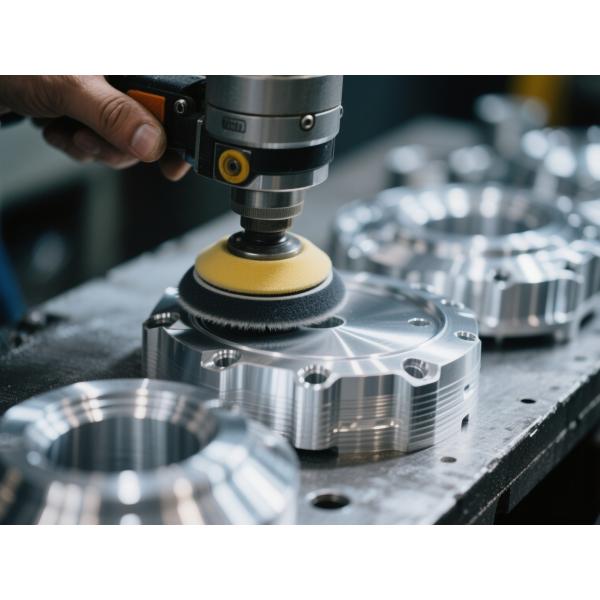Aluminum Parts Polishing: Techniques, Applications, and Precision
Standards
Aluminum parts polishing is a critical finishing process that
enhances both the aesthetic and functional properties of aluminum
components. From aerospace components requiring mirror-like
finishes to automotive parts needing corrosion resistance, the
right polishing technique can transform raw aluminum into
high-performance assets. This guide explores the most effective
polishing methods, their industrial applications, and the precision
standards that define quality results.
Key Polishing Techniques for Aluminum Parts
Aluminum’s unique properties—lightweight, malleable, and prone to
oxidation—demand specialized polishing approaches. Below are the
primary techniques, compared by precision, cost, and ideal use
cases:
Polishing Technique | Surface Roughness (Ra, μm) | Cost (per kg of parts) | Processing Time | Best For |
Mechanical Polishing | 0.02–0.1 | (1.50–)3.00 | 10–30 mins | High-volume automotive trim, consumer goods |
Chemical Polishing | 0.05–0.2 | (2.00–)4.50 | 5–15 mins | Complex geometries (e.g., heat sinks) |
Electropolishing | 0.01–0.08 | (3.50–)7.00 | 8–25 mins | Medical devices, aerospace components |
Laser Polishing | 0.005–0.05 | (8.00–)15.00 | 2–10 mins | Micro-precision parts (e.g., sensor housings) |
Table 1: Comparative Analysis of Aluminum Polishing Techniques
1. Mechanical Polishing
Mechanical polishing uses abrasive tools (buffing wheels,
sandpapers, or abrasive compounds) to physically remove surface
imperfections. It is the most widely used method for large-scale
production due to its balance of cost and efficiency.
- Abrasive Selection: Silicon carbide (SiC) grits (80–2000) for initial grinding;
aluminum oxide (Al₂O₃) or diamond pastes (1–0.1 μm) for final
finishing.
- Key Parameter: Buffing wheel speed (1500–3000 RPM) to avoid overheating, which
can cause discoloration.
- Advantage: Suitable for flat or slightly curved surfaces; minimal waste
generation.
2. Chemical Polishing
Chemical polishing immerses aluminum parts in a solution (typically
phosphoric acid, nitric acid, and sulfuric acid) that dissolves
surface irregularities. It is ideal for complex shapes where
mechanical tools cannot reach.
- Solution Composition: 60–70% phosphoric acid, 10–20% nitric acid, 5–10% sulfuric acid
(by volume).
- Process Conditions: Temperature 80–120°C; immersion time 3–10 minutes.
- Precision Note: Achieves uniform results but may reduce dimensional accuracy by
0.01–0.05 mm.
3. Electropolishing
Electropolishing is an electrochemical process that uses a direct
current (DC) to remove aluminum ions from the part’s surface,
leaving a smooth, passive layer.
- Electrolyte: Sulfuric acid (20–30%) + phosphoric acid (60–70%) solution.
- Operating Parameters: Voltage 10–20 V; current density 10–50 A/dm²; temperature
40–60°C.
- Benefit: Enhances corrosion resistance by forming a 2–5 μm thick oxide
layer; meets ASTM B912 standards for aerospace use.
4. Laser Polishing
Laser polishing uses a high-energy laser beam (1064 nm fiber laser)
to melt and reflow the aluminum surface, eliminating
micro-roughness. It is the gold standard for precision components.
- Laser Settings: Power 50–200 W; scanning speed 500–2000 mm/s; spot size 50–100
μm.
- Surface Result: Achieves Ra values as low as 0.005 μm, suitable for optical
components.
- Limitation: High equipment cost ($100,000+), making it viable only for
high-value parts.
Industrial Applications by Sector
Aluminum polishing serves diverse industries, each with unique
requirements:
- Aerospace: Electropolished aluminum alloys (e.g., 7075-T6) for aircraft
frames, requiring Ra < 0.05 μm to reduce drag.
- Automotive: Mechanical polishing for aluminum wheels (Ra 0.08–0.1 μm) and
chemical polishing for engine components.
- Medical Devices: Laser-polished 6061 aluminum surgical tools, meeting ISO 13485
standards for biocompatibility.
- Electronics: Chemical polishing for heat sinks (e.g., 6063 aluminum) to
improve thermal conductivity by 10–15%.
Step-by-Step Polishing Workflow
- Pre-Cleaning: Remove oils and debris using ultrasonic cleaning (30 kHz, 5–10
minutes) with alkaline detergent (pH 10–11).
- Surface Preparation: Use 120–400 grit sandpaper for mechanical pre-polishing; or etch
with 10% sodium hydroxide (NaOH) for chemical processes.
- Polishing: Select technique based on part geometry (see Table 1).
- Post-Treatment:
- Rinse thoroughly with deionized water (18 MΩ·cm).
- Passivate with chromic acid (5–10% solution) to prevent oxidation.
- Quality Inspection: Use a profilometer (e.g., Mitutoyo SJ-210) to verify Ra values;
perform salt spray testing (ASTM B117) for corrosion resistance.
Troubleshooting Common Issues
Issue | Cause | Solution |
Uneven finish | Inconsistent abrasive pressure | Use automated robotic polishing systems |
Surface pitting | Contaminated chemical solution | Replace electrolyte; filter to 5 μm |
Discoloration | Overheating during mechanical polishing | Reduce wheel speed; use coolant (water-based) |
Poor corrosion resistance | Inadequate post-treatment | Extend passivation time to 15–20 minutes |
Table 2: Troubleshooting Aluminum Polishing Defects
Conclusion
Aluminum parts polishing is a blend of art and science, requiring
careful selection of techniques based on part design, material, and
performance needs. Whether using cost-effective mechanical methods
or precision laser polishing, adherence to process parameters and
quality standards ensures optimal results. For industrial
applications, partnering with ISO 9001-certified polishing services
guarantees compliance with sector-specific requirements, from
aerospace to medical devices.
For custom polishing solutions or technical support, contact our
team of metallurgical engineers with 20+ years of expertise in
aluminum finishing.
